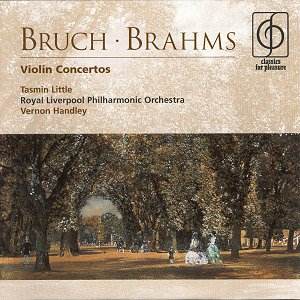 Composer: Max Bruch
Composer: Max Bruch
Works: Violin Concerto No. 1 in G minor Op. 26, Johannes Brahms: Violin Concerto in D Op. 77
Performers: Tasmin Little (violin), Royal Liverpool Philharmonic Orchestra, Vernon Handley (conductor)
Recording: Recorded in the Philharmonic Hall, Liverpool, June/July 1989 and September 1991 respectively
Label: EMI CLASSICS FOR PLEASURE
Max Bruch’s Violin Concerto No. 1 in G minor, composed in 1866, has long been a staple of the violin repertoire, often overshadowed by the towering presence of Johannes Brahms’ own Violin Concerto in D, written a decade later. Bruch, a composer who often lamented his place in the pantheon of greats, once remarked on his relative obscurity compared to Brahms, despite the enduring popularity of his concerto. This recording, featuring the luminous Tasmin Little alongside the Royal Liverpool Philharmonic Orchestra under the baton of Vernon Handley, presents an opportunity to explore the nuanced intricacies and contrasting styles of these two works, both of which showcase the violin in its full expressive range.
Tasmin Little’s performance of Bruch’s concerto is marked by a deep lyricism that captures the work’s inherent drama and romanticism. The first movement unfolds with a compelling blend of intensity and grace, where Little’s tonal sweetness and vibrato enhance the lyrical lines. Particularly notable is her phrasing, which reveals a keen sense of musical architecture—each theme unfolds with a natural ebb and flow. The Adagio, often considered the heart of the concerto, demonstrates her ability to evoke profound emotion without succumbing to sentimentality; her interpretation breathes life into Bruch’s melodies, allowing the listener to savor the rich harmonic textures. The interplay between Little and the orchestra is deftly managed, with Handley ensuring that the orchestral colors frame the soloist without overwhelming her voice.
In juxtaposition, Brahms’ Violin Concerto is a more complex tapestry, characterized by its formal rigor and deep emotional undercurrents. Little’s interpretation of the Brahms concerto reveals her technical mastery, particularly in the first movement, which is notably expansive and intricate. The weighty orchestral introduction leads into a cadenza that Little executes with precision and flair, seamlessly integrating technical prowess with musical expressiveness. The second movement, a serene and lyrical interlude, showcases her ability to create a poignant atmosphere, where the delicate dialogues between the violin and the orchestra—particularly the oboe, beautifully played by Jonathan Small—are executed with an intimate understanding of Brahms’ intentions.
The recording quality deserves commendation, especially considering the era in which it was produced. The balance between the soloist and the orchestra is meticulously crafted, allowing for a transparent soundstage that highlights both the orchestral textures and Little’s nuanced playing. Mike Hatch’s engineering provides clarity, ensuring that every nuance of Little’s performance is captured, from the subtleties of her vibrato to the crisp articulation of her double stops. This level of detail enhances the listener’s experience, making the disc a worthy addition to both Bruch and Brahms discographies.
This disc occupies a significant place in the catalog of recordings for both works, standing alongside notable interpretations by the likes of Perlman and Mullova. Little’s performance is engaging and fresh, yet it does not shy away from the emotional depth that both concertos demand. Her artistry, combined with the attentive support of Handley and the Royal Liverpool Philharmonic, results in a compelling listening experience that respects the historical context of the compositions while delivering a performance that resonates with contemporary audiences. The blend of Bruch’s lyrical brilliance and Brahms’ structural sophistication is rendered with such clarity and conviction that it invites repeated listening, illuminating the profound connections between these two composers.



